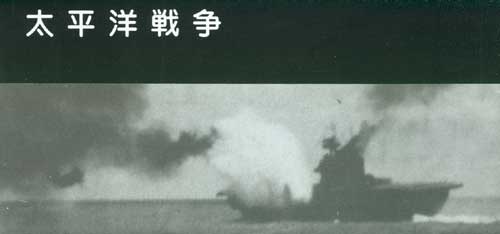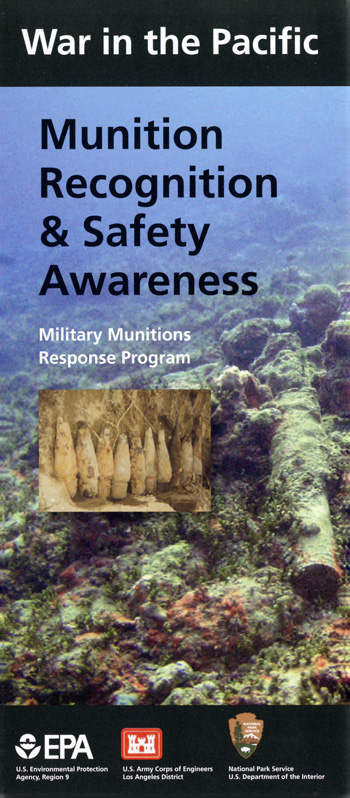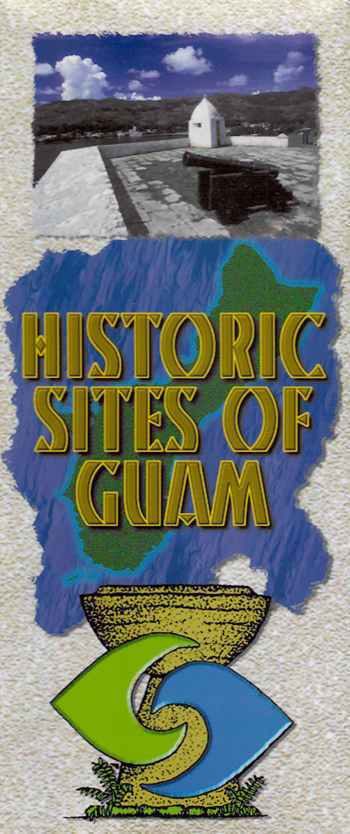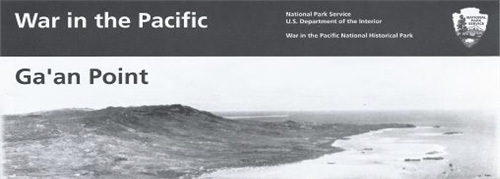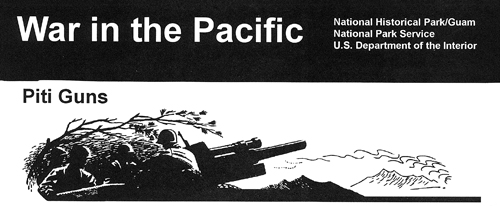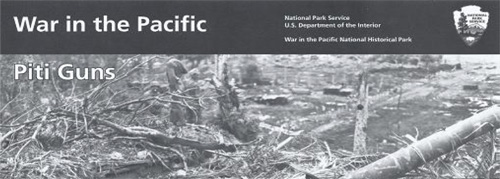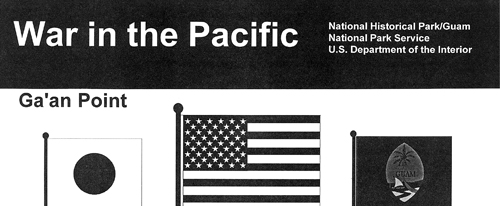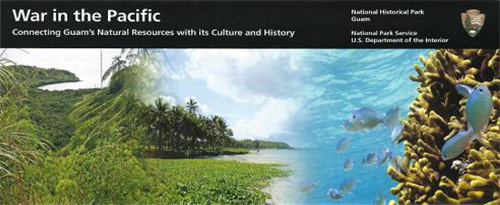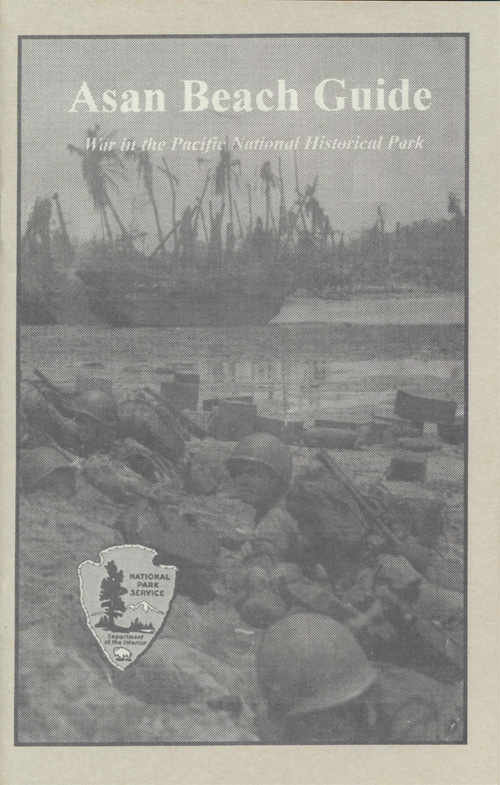|
War in the Pacific National Historical Park Guam |
 |
 NPS photo | |
BY AIR, SEA, AND LAND, World War II's devastation tore across the Pacific Ocean on a scale never before experienced in human history. The warring nations—the United States, Japan, China, British Empire, Netherlands, and many others—were based thousands of miles away. Caught in the crossfire were the people of the Pacific islands in whose hornelands and waters combat raged for four years.
Hours after their surprise attack on Pearl Harbor, December 7, 1941, Japan bombed the US Territory of Guam and within two days invaded the island. Like countless indigenous people occupied by invaders, Chamorros endured the destruction of their homes and livelihoods, forced labor, imprisonment, and executions. On July 21, 1944, US forces returned to retake the island.
War in the Pacific National Historical Park commemorates the bravery and sacrifice of all those who participated in or were affected by World War II's Pacific Theater campaigns. The park conserves and interprets Guam's outstanding places, artifacts, history, and culture. Remnants of combat and occupation—artillery, earthworks, battlegrounds—slowly succumb to the elements. What endure are the spirit, dignity, and bravery of those caught up in a world at war.
FOR THE PEOPLE OF GUAM, WAR CAME EARLY AND STAYED LATE
1941
Dec. 7 (Dec. 8 in Guam and other points west of International
Date Line) Japan's surprise attack on Pearl Harbor cripples the US
Pacific fleet; Japan moves to occupy much of Southeast Asia and western
Pacific.
Dec. 8 Japanese bomb islands of Wake, Guam, and the Philippines. On Guam, the targeted minesweeper USS Penguin is sunk outside Apra Harbor.
Dec. 8-23 Wake Island falls to Japanese; 45 Chamorro civilian airline workers are stranded.
Dec. 10 Japanese forces invade Guam. Insular Guard attempts to halt Japanese advance but is soon driven back. Capt. George J. McMillin, USN Governor of Guam, surrenders to Japan.
1942
Jan. 10 McMillin, American military and civilian personnel, and
American and Spanish clergy are taken to POW camps in Japan.
Feb.-Mar. Japanese rename island of Guam Omiyajima; the keibitai—Japanese naval police—now govern.
April After Battle of Bataan, thousands of US and Filipino prisoners perish in 62-mile forced march to Japanese prison camps.
May 4-8 Battle of the Coral Sea: Japanese sink US carrier Lexington; US stems Japanese advance.
June 4-7 Battle of Midway; Japan suffers major losses of ships, aircraft, and men.
Nov. 12-15 The decisive American victory in the Naval Battle of Guadalcanal prevents Japanese from landing reinforcements.
1943
Under keibitai rule, Chamorros may remain on their ranches but
are forced to learn Japanese language and customs. English is forbidden.
Chamorros suspected of hiding family members wanted by the Japanese or
aiding Americans ore harassed, beaten, tortured, or executed.
1944
Mar. 4 Anticipating American invasion, Japanese return to Guam to
reinforce southern Marianas. Social activities are banned, schools
closed. Laboring at bayonet point, Chamorro men, women, and children
work in fields, build defenses, and dig hundreds of shelter caves for
Japanese occupiers.
June 15 US forces invade Saipan, suffering heavy losses.
June 19-20 Battle of Philippine Sea; US Navy carrier forces devastate Japanese fleet.
Early July 10,000-15,000 Chamorros are forced to march to jungle camps with little food or water. Many do not survive march; many others die from horrific conditions in camps or on work crews.
July 21 55,000 US troops land on Asan and Agat beaches; despite 18,500 Japanese defenders, both beaches are secured.
July 24 US forces invade Tinian.
Aug. 10 US declares Guam secure. Liberation costs over 7,000 American and about 17,500 Japanese casualties. Japan's grip on the Marianas is broken.
1945
Guam transformed into military fortress. From here, US B-29s execute
bombing raids on Japan, and Apra Harbor becomes world's busiest
port.
Feb.-Apr. After 36 days of bitter fighting, US Marines take Iwo Jima; Okinawa soon secured in largest amphibious landing of Pacific war.
Aug. 6 US drops atomic bomb on Hiroshima and, 3 days later, Nagasaki.
Aug. 14 Japan accepts Allied terms for unconditional surrender; signs formal treaty Sept. 2.
AFTERMATH
1945-49 144 persons, mostly Japanese with a few Chamorros, are
tried on Guam for war crimes; 134 convicted.
They fought together as brothers in arms; they died together and now they sleep side by side ... To them, we have a solemn obligation—the obligation to ensure that their sacrifices will help make this a better and safe world in which to live."
—Fleet Adm. Chester W. Nimitz, Commander in Chief, Pacific Fleet and Pacific Ocean Arenas, 1945
A decree was sent out that night that all men should go work in the fama'ayan, the rice field ... All the men, young and old, were made to work from seven o'clock in the morning until six o'clock in the evening. They didn't feed us anything, we ate whatever we found. When it rained we continued working in the rain, even when we were soaking wet When harvesting time came, we had gained nothing ... Everything went to the Japanese soldiers.
—Jose T. Acfalle
In order to support us my mother had a soap factory ... Mama would go from house to house with the carabao cart to collect all the ashes for the soap. We used the soap to barter, one bar of soap about the size of the regular GI bars.... Every piece of soap we'd trade for one chicken or fish or vegetable.. . . My mother was killed by the Japanese.
—Lorraine Mesa Aguon
Every morning We would come out of our house to salute the Emperor. It happened that just one day before the Americans came, when we were supposed to come out that morning to be killed by the Japanese, the Japanese were all gone from camp. They had left the camp to meet the enemy...an interpreter was there at the time...the leader had told us that we were very, very lucky because we were supposed to be showered with the machine guns that evening ...
—Eugenia A. Leon Guerrero
Experience Your National Park on Guam
PLAN YOUR VISIT
 (click for larger map) |
War in the Pacific National Historical Park invites you to explore Guam's World War II experience as well as its natural world.
Start at the T. Stell Newman Visitor Center in Sumay on Marine Corps Drive (Rt. 1). Interactive exhibits and films portray the events of the Battle of Guam and tell the stories of combat veterans, as well as Chamorros and other Pacific Islanders.
The Pacific Historic Parks Bookstore, operated by the park's nonprofit partner group, offers a comprehensive selection of Pacific Theater and Guam history publications, films, and memorabilia.
STAY SAFE, PROTECT THE PARK
Historic structures, military equipment, and earthworks like foxholes
and trenches date from the 1940s or earlier and are very fragile. Help
us protect these features by not disturbing them.
Federal law protects all natural and cultural features on land and in the water. Please leave cultural and natural objects in their original place. Contact a park ranger if you have any questions.
For your safety do not open or enter any caves or tunnels; they are fragile and may contain hidden explosives.
Some lands in the park are privately owned. Please respect these property rights and do not trespass.
ACCESSIBILITY
We strive to make our facilities, programs, and services accessible to
all. To learn more, ask at the visitor center or check our website.
EXPLDRE—AND MORE
Amphibious assaults. Bombardments. Hard jungle fighting against well-entrenched Japanese forces. The events on Guam echo the island-to-island combat throughout the Pacific Theater. Learn more at these park sites.
ASAN BEACH UNIT
On July 21, 1944, US Navy ships bombarded the island while the US Third
Marine Division rushed ashore to retake Guam. The remains of an American
landing craft, encrusted in coral, lie just offshore. Look for the large
cave along the ridgeline; it was built during the war by Chamorro
laborers.
The Liberators' Memorial at Asan Point, installed for the 50th anniversary of the battle, honors the US military forces and local Guam Combat Patrolmen who fought on the island.
The Asan Ridge Trail leads to spectacular views of the beach as well as the remains of hidden Japanese fortifications.
ASAN INLAND UNIT
Dense jungle growth and swordgrass savanna obscure this site where
entrenched Japanese troops attacked US Marines fighting to take the high
ground.
The Asan Bay Overlook features a Memorial Wall etched with the names of Americans who died defending and liberating the island, along with the names of the people of Guam who suffered the hardships of war and who lost their lives.
PITI GUNS UNIT
A trail leads you to three WWII Japanese coastal defense guns. Chamorros
built Japanese defense structures like these throughout Guam. This
historic trail leads you through the dense mahogany forest planted in
the 1920s.
FONTE PLATEAU UNIT
This is the former command post of General Takeshina, commander of the
Japanese forces on Guam. Secluded in the cliffside among dense
vegetation, the U-shaped concrete bunker protected Takeshina and his
staff. Nearby is a former quarry from which coral was taken for road
construction on the island.
MT. CHACHAO/MT. TENJO UNIT
Undeveloped site. In 1944 this Japanese strongpoint had caves and
tunnels fortified by foxholes and machine gun nests. From here, US
Marines and Army forces joined in pushing the Japanese troops to the
northern end of the island.
AGAT UNIT
A significant Japanese stronghold defended the bay. Elaborate camouflage
made it all the more deadly to advancing US Marines and Army troops who
stormed the southern beachhead in July 1944. Several pieces of American
military equipment remain underwater near the edge of the reef.
From this unit you can view Orote Peninsula where US forces captured the airfield and Marine air power was used for close combat support missions during the battle for Guam.
MT. ALIFAN UNIT
Undeveloped site. From the high ground Japanese troops could spot
incoming US military forces, landing craft, and warships. These hills
saw heavy fighting between the United States and Japanese forces.
MODERN BATTLES ON A NEW FRONT
The park protects coral reefs, seagrass beds, savanna grasslands, bogs, streams, limestone forests, coastal and forest wetlands, offshore islets, and a mahogany forest.
With rare and endangered animals, these habitats create a living laboratory for scientific research. They also face a variety of threats: disease, invasive species, habitat loss, and climate change.
An astounding number of organisms live in and around the park's reefs, especially rich—and vulnerable—communities. More species of invertebrates, fish, and corals inhabit these reefs than Hawaii's.
This biodiversity forms a complex ecosystem. On Guam reefs, you will find herbivores like kichu (convict tangs) and palakse (bullethead parrotfish) as well as predators like groupers and jacks. These fish were an important part of the traditional Chamorro diet and are still taken for food today.
Over time coral reefs have been used—and abused. Natural occurrences like storms and wildfires permanently alter shorelines. Human impact continues to take its toll. Fossil fuels release greenhouse gases into the atmosphere and contribute to global warming. Clearing an burning vegetation allows more sediment to wash into the ocean and onto coral reefs. Taking fish from the reef faster than they can reproduce disrupts the balance of the food web.
As you explore the park's lands and waters, keep in mind your role as a steward of these irreplaceable treasures.
Source: NPS Brochure (2017)
|
Establishment War in the Pacific National Historical Park — Aug. 18, 1978 |
For More Information Please Visit The  OFFICIAL NPS WEBSITE |
Brochures ◆ Site Bulletins ◆ Trading Cards

Documents
A Rapid Ethnographic Assessment Project for the Asan Beach Unit and Agat Unit Management Plan, War in the Pacific National Historical Park,, Territory of Guam — Volume I: Narrative (M.J. Tomonari-Tuggle, September 2021)
A Rapid Ethnographic Assessment Project for the Asan Beach Unit and Agat Unit Management Plan, War in the Pacific National Historical Park,, Territory of Guam — Volume IIa: Oral History Transcripts - Asan (Rlene Santos Steffy and M.J. Tomonari-Tuggle, September 2021)
A Rapid Ethnographic Assessment Project for the Asan Beach Unit and Agat Unit Management Plan, War in the Pacific National Historical Park,, Territory of Guam — Volume IIb: Oral History Transcripts - Asan and Agat (Rlene Santos Steffy and M.J. Tomonari-Tuggle, September 2021)
Administrative History: War in the Pacific National Historic Park (HTML edition) (Evans-Hatch & Associates, July 2004)
Asan and Agat Units Management Plan and Environmental Assessment, War in the Pacific National Historical Park (January 2024)
Botanical survey of the War in the Pacific National Historical Park, Guam, Mariana Islands Pacific Islands Cooperative National Park Resources Studies Unit Technical Report No. 161 (J.M. Yoshioka, July 2008 )
Coastal Hazards & Climate Change Asset Vulnerability Assessment: War in the Pacific National Historical Park (K. Peek, B. Tormey, H. Thompson, R. Young, S. Norton, J. McNamee and R. Scavo, April 2017)
Coral Bleaching, Mortality and Benthic Community Assemblages on the Reefs within the Pacific Island Network National Parks NPS Natural Resource Report NPS/PACN/NRR-2021/2322 (Amanda L. McCutcheon and Sheila A. McKenna, November 2021)
Coral Reefs in the U.S. National Parks: A Snapshot of Status and Trends in Eight Parks NPS Natural Resource Report NPS/NRPC/NRR-2009/091 (Nash C. V. Doan, K. Kageyama, A. Atkinson, A. Davis, J. Miller, J. Patterson, M. Patterson, B. Ruttenberg, R. Waara, L. Basch, S. Beavers, E. Brown, P. Brown, M. Capone, P. Craig, T. Jones and G. Kudray, April 2009)
Coral Species Inventory at War in the Pacific National Historical Park NPS Natural Resource Report NPS/WAPA/NRR-2024/2619 (Kelly O'Connell, David Burdick, Melissa Vaccarino, Colin Lock, Greg Zimmerman and Yakuta Bhagat, January 2024)
Cultural Landscapes Inventory: War in the Pacific National Historical Park (2013)
Final Integrated Trip Report--Site Visits to Area 50, Andersen Air Force Base, Guam National Wildlife Refuge, War in the Pacific National Historical Park, Guam, Rota and Saipan, CNMI, 2004-2005 USGS Open-File Report 2005-1299 (Steven C. Hess and Linda W. Pratt, 2006)
Fire, Erosion, and Sedimentation in the Asan-Piti Watershed and War in the Pacific NHP, Guam Pacific Islands Cooperative National Park Resources Studies Unit Technical Report No. 150 (D. Minton, November 2006)
Foundation Document, War in the Pacific National Historical Park, Guam (February 2017)
Foundation Document Overview, War in the Pacific National Historical Park, Guam (January 2017)
General Management Plan, War in the Pacific National Historical Park, Guam (March 1983)
General Management Plan/Environmental Assessment, War in the Pacific National Historical Park, Guam (March 1983)
General Report on the Archeology and History of Guam (Erik K. Reed, 1952)
Geologic Resources Inventory Report, War in the Pacific National Historical Park NPS Natural Resource Report NPS/NRPC/GRD/NRR-2012/573 (T.L. Thornberry-Ehrlich, September 2012)
Guam (Archive of Expanded NPS Website)
Guam Comprehensive Outdoor Recreation Plan (October 1977)
Guam Report: A Study of the Territorial Government's Department of Public Safety (Harold F. Stewart, 1963)
Guam: Two Invasions and Three Military Occupations, A Historical Summary of War in the Pacific National Historical Park, Guam (Russell A. Apple, 1980)
Historic Properties Policy and Program in Micronesia (Trust Territory of the Pacific Islands:) Report, Recommendations and Examples (Russell A. Apple, July 1972)
Historic Resource Study: War in the Pacific National Historical Park, Guam (HTML edition) (Erwin N. Thompson, July 1985)
Inventory of the reptiles of the War in the Pacific National Historical Park Guam Pacific Islands Cooperative National Park Resources Studies Unit Technical Report No. 169 (G.H. Rodda and K. Dean-Bradley, October 2001)
Investigation of the Possible Connection of Rock and Soil Geochemistry to the Occurrence of High Rates of Neurodegenerative Diseases on Guam and a Hypothesis for the Cause of the Diseases USGS Open-File Report 2002-475 (William R. Miller and Richard F. Sanzolone, 2003)
Junior Ranger, War in the Pacific National Historical Park (Date Unknown; for reference purposes only)
Land Protection Plan (April 1984)
Marine Biological Resources Within the Guam Seashore Study Area and the War in the Pacific National Historical Park University of Guam Marine Laboratory Technical Report No. 57 (L.G. Eldredge, November 1979)
Marine Water Quality in War in the Pacific National Historical Park: Summary Report 2009-2014 NPS Natural Resource Data Series NPS/PACN/NRDS-2017/1122 (David F. Raikow, Anne Farahi, Amanda L. McCutcheon and Scott Kichman, October 2017)
Marines in World War II Commemorative Series
Museum Management Plan: War in the Pacific National Historical Park, American Memorial Park (Kent Bush, Tammy Ann Duchesne, Steve Floray, Diane Nicholson, Scott Pawlowski, Deb Sheppard and Brigid Sullivan Lopez, 2008)
National Park Service — Guam Study (June 1965)
National Register of Historic Places Nomination Forms
Agat Invasion Beach (Guma Inventory Team, August 1974)
Asan Invasion Beach (Guam Inventory Team, August 1974)
Asan Invasion Beach (David T. Lotz, January 10, 1979)
Asan Ridge Battle Area (Asan Ridge, Bundschuh Ridge and Chorrito Cliff (David T. Lotz, April 25, 1975)
Matgue River Valley Battle Area (Guam Inventory Team, September 1974)
Piti Coastal Defense Gun (David T. Lotz, April 25 1975)
Pacific Theater (Archive of Expanded NPS Website)
Paleontological Resource Inventory (Non-Sensitive Version), Walnut Canyon National Monument NPS Natural Resource Report NPS/WACA/NRR-2018/1658 (Diana M. Boudreau, Justin S. Tweet and Vincent L. Santucci, June 2018)
Preliminary Historical Preservation Plan (June 30, 1972)
Relative coastal vulnerability assessment of War in the Pacific National Historical Park (WAPA) to sea-level rise USGS Open-File Report 2005-1056 (Elizabeth A. Pendleton, E. Robert Thieler and S. Jeffress Williams, 2005)
The Recapture of Guam (Major O.R. Lodge, 1954)
The War in Micronesia: A Briefing Paper Prepared for the U.S. Park Service of Guam (Dirk Anthony Ballendorf, February 1980)
Vegetation Inventory Project: War in the Pacific National Historical Park NPS Natural Resource Report NPS/PACN/NRR-2014/807 (Dan Cogan, Gwen Kittel, Meagan Selvig, Kathryn Akamine, Alison Ainsworth, David Benitez and Greg Kudray, May 2014)
War in the Pacific National Historical Park (Archive of Expanded NPS Website)
War in the Pacific National Historical Park, Guam: Revision of 1967 Proposal (September 1977)
Water Quality in the Asan River, War in the Pacific National Historical Park: Summary Report 2007–2012 NPS Natural Resource Data Series NPS/PACN/NRDS-2014/662 (David F. Raikow and Anne Farahi, May 2014)
Books

wapa/index.htm
Last Updated: 09-Feb-2024


